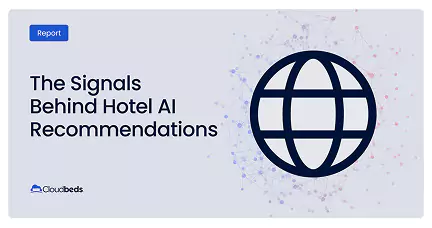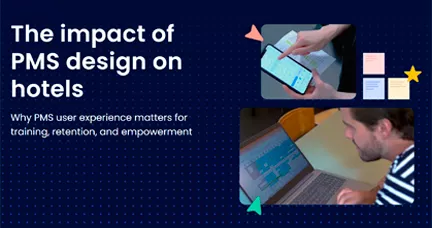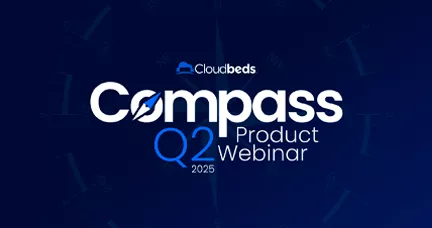Modern hotel management requires a robust set of tools and metrics to evaluate and continuously optimize revenue performance, especially in relation to competitors.
Among these, the average rate index (ARI) is one of the lesser-known but extremely useful metrics to keep under check. In this article, we explore what ARI is and how to use it to improve revenue performance.
What is the average rate index (ARI)?
The average rate index (ARI) is a metric that allows hoteliers to evaluate the performance of their room rates relative to a group of competitors during a specific period. This index can vary according to the business strategy, and factors impacting it include the average daily rate (ADR), occupancy rate, quality of services offered, marketing strategies, reputation, and more.
How is ARI calculated?
Calculating ARI requires hotels to collect detailed room performance data. Here’s the ARI formula to use:
ARI = (Hotel ADR / Compset ADR) * 100
ARI is part of a set of three performance indicators that measure hotel revenue performance by comparing it to a competitive set.
The other two indicators are MPI (market penetration index) and RGI (revenue generated index). In order to make the best decisions, it’s important for hotels to measure and track all three indicators to have a full overview of their performance and market.
Market penetration index (MPI)
Market penetration index (MPI) measures the number of rooms sold by a hotel relative to its competitors. Here’s the MPI formula:
MPI = (Hotel Occupancy / Compset Occupancy) * 100
This formula finds the actual market share obtained by dividing the hotel’s occupancy by the competitors’ occupancy. Another metric to look at is the fair market share, obtained by dividing the hotel’s available rooms by the competitors’ available rooms.
The difference between the two is that actual market share measures the market share that the hotel actually obtains, as it is calculated on the basis of actual rooms sold, while fair market share measures a hypothetical market share that would be obtained if all competitive hotels sold all their rooms (it is calculated on the basis of available rooms).
Revenue generation index (RGI)
The other indicator is the revenue generation index (RGI), which measures the efficiency with which a hotel generates revenue relative to its competitors. Here’s the RGI formula:
Revenue Generation Index = (Hotel RevPAR / Compset RevPAR) * 100
RGI compares a hotel’s RevPAR with that of competitors, providing a measure of how effectively the hotel generates revenue.
Calculate your property’s ADR, RevPAR, and occupancy rate.
ARI use cases
The average rate index is a crucial indicator that helps hoteliers keep a pulse on the market and adjust pricing for increased profitability. Here are a few ways that ARI is used in the hotel industry.
1. Competitive benchmarking
ARI enables hoteliers to compare their performance with that of their competitors or with a market benchmark. This comparison is essential to determine whether pricing and marketing strategies are effective.
By doing competitive benchmarking, hoteliers can assess how well strategies perform over different periods. For instance, a hotel’s base ARI is expected to be 100 compared to the group of competitor hotels. Historically, this is described as “fair share” of the market performance. A high ARI (over 100) in one season and a low ARI (below 100) in another indicate there’s probably at least one competitor with a better pricing strategy.
2. Pricing strategies optimization
A high ARI (above 100) suggests that your room rates are in line with or above market rates, reflecting good customer perception of value. Conversely, a low ARI could indicate the need to review pricing strategies or improve service offerings. However, this should always be assessed in relation to sales strategies. A high ARI at a low MPI may indicate that high rates have been offset by a lower number of rooms sold.
3. Market and trend monitoring
ARI provides useful data to monitor short—and long-term trends, allowing hotels to identify periods of high or low demand and adjust strategies accordingly.
How technology can help
Technology is transforming the way hotels collect and analyze market and competitive data. What used to be a daunting task that took countless hours is now streamlined and automated with advanced technologies.
Tools such as revenue management software (RMS) now provide access to real-time information on market trends, local events, and competitor pricing. In the case of Smartpricing, for example, the software works as follows:
- Continuous collection of internal and external data sets that are constantly cross-referenced with past and future booking data, local market trends, events, public holidays, etc.
- Specialized algorithms process the collected data and calculate starting prices, applying the most effective dynamic pricing strategy tailored to the establishment.
- Price updates are automatically published in real-time via the PMS integration.
This automation and immediacy deliver more accurate demand and price forecasts and reduce the risk of human error.
By leveraging these solutions, hoteliers can adjust their strategies on the fly, ensuring that their prices are always competitive and reflect current market conditions. This not only maximizes revenue but also frees up time to focus on other priorities, such as enhancing the guest experience.
Final thoughts
Among the many performance metrics, ARI plays an important role that enables hoteliers to analyze their performance in relation to competitors, excluding market variables that could give a distorted perception of the situation. By keeping a constant eye on ARI, hoteliers gain invaluable information that is essential to informed decision-making.
With the advent of cutting-edge technologies, many tools now make hotel management more efficient and less burdensome. AI-powered dynamic pricing and revenue management systems, for example, are changing the game, enabling hoteliers to define optimal pricing strategies by constantly monitoring market trends and competitors, amongst other factors. Adopting these technologies not only simplifies complex tasks but also ensures that hoteliers can offer the best prices at all times, strengthening their competitive edge.
A post by Smartpricing
Co-founded by Luca Rodella, Eugenio Bancaro, and Tommaso Centonze, and based in Trentino, Italy, the company launched its software in 2020. Since then, Smartpricing has helped more than 3,000 hospitality businesses optimize their pricing.
The revenue management software uses AI-powered algorithms to calculate the best rates. Through machine learning and automation, Smartpricing helps hosts increase sales and gain the confidence to offer market-driven prices. Since its creation in 2020, Smartpricing has become the fastest-growing B2B SaaS company in the European hospitality sector.
At Cloudbeds, we’re proud to partner with solutions like Smartpricing to help lodging operators optimize pricing.



